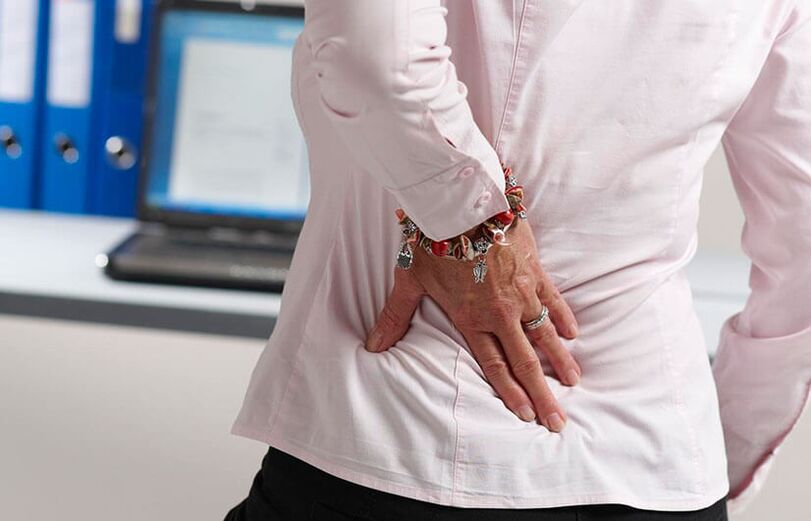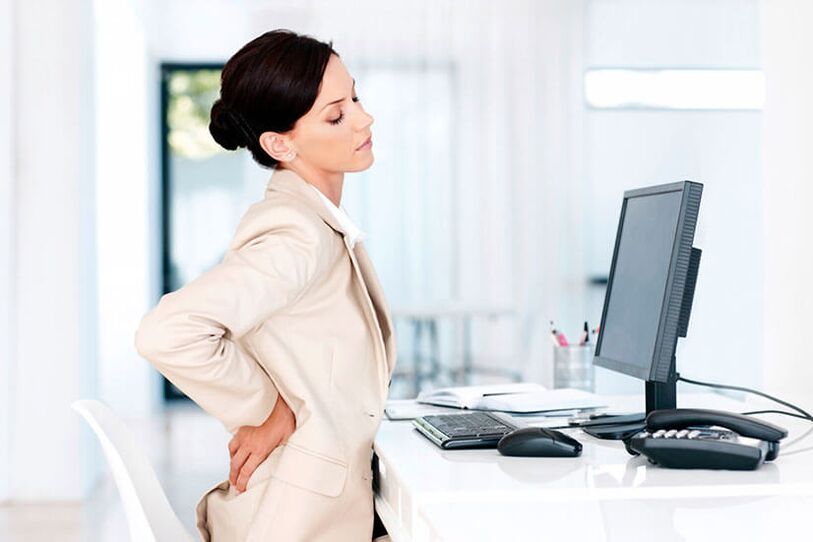Low back pain is a common and common phenomenon.Men, women and children suffer from it.The causes of this disease are diverse.

Pain itself is a "wake-up call" for any changes in the human body.Pain should not be ignored; it can have serious consequences.You should contact an expert to identify the source and start eliminating it.
Causes of low back pain
The most harmless cause is fatigue.The loads placed on the spine during the day are large and unevenly distributed.This can lead to an unpleasant painful sensation in the spinal area.Excessive physical activity and heavy lifting.
Of course, there are also various injuries and abrasions
Causes can be divided into two broad categories: spinal diseases and visceral diseases.
The causes of pain in most women are:
- Gynecological diseases (uterine fibroids, vulvitis, adnexitis, internal reproductive organ tumors).
- Pregnant.Especially in the third trimester of pregnancy, the spine bears a heavy load, causing low back pain.This is a natural phenomenon and will disappear after delivery.
- menstrual cycle.Recoil symptoms are likely to occur.
- abortion.After stress and inflammatory processes.
- climax.Changes in hormonal levels can cause disruption of blood circulation in the pelvis.Osteoporosis occurs.
For men:
- Characteristics of professional activities.(weightlifting).
- prostatitis.Rare, but possible.
- Reproductive Oncology.50 years later.
- Do exercise.Too much load.
child:
- Incorrect posture.This is caused by improper shoes, improper carrying of backpacks, bending over to read, etc.
- Spinal hernia.
In addition to spinal disorders, pain can also be caused by:
- Congenital defects of the spine (irregular shape, splitting);
- appendicitis;
- cholecystitis;
- kidney disease;
- adhesions;
- Tumors in the back area;
- Bone tuberculosis;
- overweight;
- diseases of the small intestine;
- Inflammatory process in muscles.
What diseases can cause low back pain?

The disease has primary and secondary symptoms.The main ones include the spinal disease itself.Secondary ones include reflex pain and internal organ diseases.
Let's look at the most common of them:
- Injuried.Broken bones, bruises.Received due to falls, impacts, accidents, sports, etc.
- Scoliosis.Curvature of the spine.The bones become deformed and develop a hump.Have an innate or acquired character.
- Osteochondrosis.Joints and bones are damaged, and nerve fibers are affected.Can cause radiculitis, hernia, and disc herniation.
- Osteoporosis.Calcium and phosphorus metabolism disorders.Bone density decreases and the rate of injury increases.
- Rheumatoid arthritis.A chronic inflammatory process of a joint involving adjacent ligaments and muscles.The development of autoimmune processes is the culprit.
- Blood clots in the veins (thrombophlebitis).Complete or partial interruption of blood flow.
- Ankylosing spondylitis.Connective tissue grows and mobility is lost.
- Spondylosis.Joints age naturally.
- Low back pain.Destructive changes in the spine are accompanied by acute pain.If left untreated, it will lead to irreversible consequences.
- Various kidney diseases can cause low back pain: pyelonephritis, renal prolapse, renal failure, gout, amyloidosis, diabetic nephropathy, renal colic, etc.
- Types of gastrointestinal and duodenal tumors.
- Pathology of the pelvis.
Symptoms and nature of pain
Symptoms include varying degrees of discomfort in the lower back.Pain in the lower back comes in many forms.
Divided into periodic and permanent.Periodic symptoms are related to the acute pathology, physical activity and some other individual features of the skeletal structure.
Permanent damage results from irreversible damage to the motor system.They cannot fully heal and recover.
Pain syndromes can also be primary and secondary.The first is directly related to the musculoskeletal system itself, while the second is not related to the musculoskeletal system but is caused by the pathology of other diseases.
Important!The nature of pain varies: acute, aching, periodic, sharp, pulling, throbbing, aching, mild.Some cases are accompanied by numbness of the lower limbs, chills, decreased leg sensitivity, pale complexion, convulsions, limp, limited activity, and paralysis.
diagnostic methods

If the cause of the pain is known (trauma, pregnancy, chronic disease), you should immediately see a more specialized specialist.Otherwise, first you need to see a therapist.
Next, the following procedures will take place:
- Blood and urine tests, biochemical analysis.
- Ultrasound examination of abdominal and cardiac internal organs.
- X-ray of the lumbar area.
- MRI and CT.The most accurate test to determine the source of illness.
- Vascular research.
Based on these results, the cause will be determined and appropriate treatment taken.
What to do if you have lower back pain?
first aid

Dull, sharp or throbbing pain, whatever it is, can make life very difficult and prevent you from doing the things you normally do and enjoy.
If an unexpected situation occurs, the following measures must be taken:
- Lie on a semi-rigid, flat surface so that your spine assumes the correct shape.
- Try to relax.Don't be nervous or panic.Self-hypnosis also plays an important role.
- Call a doctor.Painkillers are not recommended; doctors will not be able to accurately determine the source of the illness.
- It can be bandaged (immobilized).
- Measure the temperature.
During pregnancy:
- Exclude physical activity;
- Wear a prenatal bandage;
- Perform simple physical exercises while seated;
- Eat more potassium and phosphorus.
drug treatment
Tablet:
- Nonsteroidal anti-inflammatory drugs (NSAIDs).Fights inflammation, swelling, and improves mobility.
- Chondroprotectant.Prevents cartilage tissue destruction and promotes its recovery.
- Muscle relaxants.Relax stiff muscles and relieve pain.They are used when NSAIDs do not have the desired effect.
- Corticosteroids.Prevents inflammatory processes and relieves severe pain.
- Narcotic analgesics.They should only be purchased at pharmacies with a doctor's prescription as they are addictive.
- Painkillers.Depends on the intensity and nature of the pain.
- B vitamins.They are used in combination with non-steroidal anti-inflammatory drugs.Vitamin complex and B1, B12, B6 vitamins.
Ointments and creams:
- Preparations with local stimulating and analgesic effects.Reduces discomfort, relaxes muscles, anti-inflammatory, nourishes, and warms.
- Warm with chilies, snake venom and bee venom.
- Cartilage protection.
Good to know!Patches and injections are also used to treat low back pain.If all the above measures fail to achieve the desired results, do the latter.The injection is placed directly into the lumbar area.
folk remedies
Once again we turn to traditional medicine.There are many folk treatments, but you need to consult a specialist before using them yourself, as these treatments may have contraindications.
Let's look at a few examples:
- Use fresh or steamed burdock leaves as a dressing.
- Mustard paste mixed with honey.
- Mix crushed garlic with vegetable oil.The garlic is also mixed with petroleum jelly and a spoonful of lemon juice.Apply to areas that are bothering you.
- Mix lavender, orange, rosemary, eucalyptus, fir, and camphor oils with petroleum jelly.The result is a warming ointment.
- Apply hot compress with mustard powder.Another 200 grams.Pour the dry mustard into the tub.After taking it, wrap yourself in a warm blanket.
- Stir a tablespoon of honey and vinegar and place over the cabbage leaves.Apply to the painful area and tie tightly with a warm scarf.
- Eucalyptus alcohol tincture can relieve pain.Wipe the areas that are bothering you.
- Mix sage leaves, birch, pine buds, chamomile, plantain, fennel, and burdock root with melted butter or lard.
- Grate the beets and squeeze.Mix the cake with a spoonful of kerosene and place it on a napkin or thin cloth.Works on what worries you the most.Place polythene on top and wrap with something warm.
- Infusions and decoctions of herbs, fruits, and roots work wonders when taken orally.They fight inflammation, replenish the body with vitamins and speed up metabolic processes.Useful plants: chamomile, knotweed, St. John's wort, burdock root, calendula, violets, dandelions, white willow bark, knotweed, helichrysum.
physical therapy
Physical therapy procedures can enhance the effects of medications on the body.
Together they give a wonderful result:
- Paraffin and ozokerite applications.It warms the affected area completely, applying heated wax layer by layer to a height of up to 1 cm.Then cover with film and wrap with felt for one hour.Courses last from 10 to 30 days.
- Electrophoresis.The process is performed using special equipment that provides a weak electrical signal.There is a tingling sensation.
- Electrical stimulation of muscles.
- Pearl and turpentine baths.
- Mud therapy.Significant anti-inflammatory and pain-reducing effects.
- Api pulse therapy.
gymnastics
Gymnastics or physical therapy will help strengthen the muscles and speed healing.
An orthopedic surgeon or chiropractor selects specific exercises based on the injury and other indications.
Therapeutic exercises should be performed after the inflammatory process has passed and the pain has subsided.
Continuous exercise can enhance the strength of back muscles, reduce the burden on bones, speed up blood circulation, and thus promote tissue metabolism.
The first sessions are conducted under the guidance of a doctor, then independently at home.The exercise of arching your back up and down can be helpful.and get down on all fours, bending in one direction or another.
Walks and visits to swimming pools can be helpful.
massage
The benefits of massage are huge, but if it's lower back pain, it must be performed by an experienced massage therapist.Otherwise, incorrect movements can cause injury and accelerate the progression of the disease.
If the massage movements are correct, it can warm up, relieve spasms, and activate blood microcirculation.It has beneficial effects on the entire body and on the mood of the patient.
During massage, techniques such as fingertip rubbing, stroking, and kneading of muscles are used.
Precautions
- Physical exercise is very helpful in prevention.
- You should not make sudden movements.
- Boost your immune system and live a healthy lifestyle.
- What's important to note is your posture.
- Get checked by a doctor once a year.
- Proper nutrition and maintenance of water balance in the body.
- Avoid stress and nervous shock.
Notice:It is worth monitoring your health and consulting a doctor for prompt treatment.Listen to your body’s warning signals in the form of pain.Do not self-medicate.Because all this may lead to irreversible consequences.

























